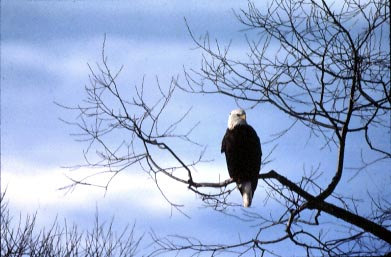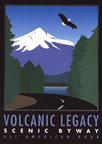Wildlife
 The Volcanic Legacy Scenic Byway contains some of the richest wildlife habitat in the western part of the United States. Many unique and diverse landscapes come together through this area. The Byway encompasses the northern range of many species of the Sierra Nevadas, the southern range of many species in the Cascade range, and the western range of Great Basin animals. Viewing wildlife in their natural surroundings is one of the area's most popular and rewarding activities.
The Volcanic Legacy Scenic Byway contains some of the richest wildlife habitat in the western part of the United States. Many unique and diverse landscapes come together through this area. The Byway encompasses the northern range of many species of the Sierra Nevadas, the southern range of many species in the Cascade range, and the western range of Great Basin animals. Viewing wildlife in their natural surroundings is one of the area's most popular and rewarding activities.
Please follow the links below to discover information on the wildlife found along the Volcanic Legacy Byway.
Read about the Animals of Crater Lake National Park with links to pages with a List of Endangered Animals, List of Mammals, Black Bears, List of Birds, Spotted Owls, Peregrine Falcons, Amphibians and Reptiles, Fish, The Porcupine and Animals in Winter. Great information from the National Park web site.
Check out The Call of the Wildlife page, and links, at the Southern Oregon Visitor's Association web site.
The Klamath County Department of Tourism Wildlife page offers photos and information on the wildlife of the Klamath Basin's seven National Wildlife Refuges.
The Bear Valley National Wildlife Refuge in southern Oregon was established in 1978 to protect a vital night roost site for wintering bald eagles. In recent years, as many as 300 bald eagles roost here, and fly out daily to the nearby basin marshes to hunt...a world-famed sight in winter months.
The Annual Bald Eagle Conference has been held yearly since 1978 in Klamath Falls, Oregon. The conference features guided field trips to the nearby refuges, including the popular Bear Valley "fly-out," to view eagles at close range.
The Tule-lake.com brings you to the Heart of the Pacific Flyway. Six national wildlife refuges, three state wildlife areas, and thousands of acres of private farmlands converge to provide habitat for a wide variety of waterfowl, shorebirds, songbirds, raptors, big game, small mammals and aquatic life. Millions of birds stop here throughout the year to feed, rest, and raise their young, they find the combination of water, fields, cliffs and trees an ideal sanctuary.
The Natural Resources page at the Lava Beds National Monument web site offers detailed information on the Flora and Fauna of the area, including Bats and Bat Facts, Mountain Lions and Coyote the Trickster.
The Birding Pages at the Siskiyou County Visitors' Bureau web site bring you a rich collecion of links, information sources and resources on birding in Siskiyou County and northern California.
The Modoc National Forest is home to more than 300 species. Discover viewing areas, species lists and Modoc's unique wild horse and burro herd territories at the Modoc NF Watchable Wildlife at the Lava Beds National Monument web page.
A valuable resource for the traveler interested in wildlife is the California Wildlife Viewing Guide, a $12.95 full-color guidebook to 200 of California's best wildlife-viewing areas. The book features detailed site descriptions, side trips, viewing tips, and easy-to-follow directions. This guide was created through the National Watchable Wildlife Program, a partnership initiative coordinated by Defenders of Wildlife.
You will discover great information about wildlife viewing at the Eagle Lake Watchable Wildlife page from the California Bureau of Land Mangement web site. There's a list of animals you may see here, viewing tips for this area, and driving directions for reaching Eagle Lake from Susanville, a gateway community for the Volcanic Legacy Byway.
The Wildlife and Wild Places in The Plumas National Forest web page describes wildlife viewing sites in and around the Plumas National Forest.
The Northern Plumas County Guide to Birding gives directions to a dozen more of the best birding areas in the Lake Almanor area.
The Birds and Wildlife of Plumas County are described at the Plumas County Visitors Bureau web site. Here you'll find directions to the Antelope Lake-Indian Creek Wildlife Viewing Site, with its surrounding wet meadowlands (an excellent place to see migratory waterfowl from April through November) and the Lake Davis Wildlife Viewing Site (with nesting Canada geese, tundra swans, bald eagles and ospreys, deer and bats).
- Crater Lake
- Upper Klamath Lake & Klamath Falls
- The Klamath Basin, Tulelake & Lava Beds
- Butte Valley
- Mount Shasta
- The Waterfalls, McCloud and Burney
- Hat Creek Rim
- Lassen Peak Region
- Lake Almanor
-
Interests
- Trip Planner
- Volcanic Spectacles
- Waterfalls
- Wildlife
- History
- Recreation
- Travel with Kids
- Lodging & Services
- RV & Camping
- Fishing & Hunting
- Scenic Wonders
- 2011 Calendar

 VolcanicLegacyByway.org is the Official Website for The Volcanic Legacy Scenic Byway All-American Road in California and Oregon.
VolcanicLegacyByway.org is the Official Website for The Volcanic Legacy Scenic Byway All-American Road in California and Oregon.